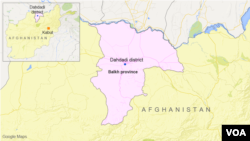For decades in a small village in northern Afghanistan's Balkh province, dozens of families have lived in one- and two-story houses made from ammunition, where 3-meter-long live rockets are used as ceiling beams.
After a few explosions, the villagers now want the Afghan government to remove the weapons.
Qand Agha, leader of Qazi Abad village, told VOA that several people have been wounded or killed because the rockets have exploded.
"A villager was killed when he was trying to move and place one of the rockets on his home's roof," Agha said.
WATCH: Afghan Villagers Use Live Rockets to Build Homes, Bridges
About 400 Russian-made BM-21 rockets have been used as beams in an estimated 40 houses. Villagers tried to keep the weapons a secret because they did not want to lose the materials for their houses, but periodic explosions forced them to inform the government.
Mohammad Zarif, a local shepherd, said a rocket exploded as he was collecting them.
"I was tending cattle then, and used to collect the rockets. One day, a rocket exploded, and I lost one of my eyes," he said.
Sayed Mohammad Yazdanparast, spokesperson for the Advocacy Network on Disabilities in Balkh, said there were many other such residences in the province.
"These people are poor, and fear of losing their houses has forced them not to report it to the authorities," Yazdanparast said.
Remove and rebuild
Recently, a team at the Danish Demining Group, a humanitarian mine action unit in the Danish Refugee Council, visited the village and promised to remove and neutralize the rockets and rebuild the houses.
"This is life-threatening for the villagers, especially for kids living here," said Abdul Hakim Noorzai, DDG's chief of operations.
Removing all the rockets from 40 houses could take up to two months to complete, DDG said.
War remnants
Afghanistan is one of the most mined countries in the world. Since 1979, when the Soviet Union invaded the country, an estimated 640,000 land mines have been buried across the country, according to HALO Trust, an international humanitarian mine clearance organization.
Local and international demining organizations, including Halo Trust, have worked for decades to clear the mines and unexploded ordnance in Afghanistan. They have cleared large swaths of areas in the country, but remnants of war, including unexploded ordnance, continue to kill and injure Afghans.
Though some of the explosives found in Afghanistan date to the Soviet invasion, others are from recent wars, including the civil war of the 1990s and the ongoing Taliban insurgency. The Taliban rely heavily on improvised explosive devices to carry out roadside bombings in parts of the country.
Each year, unexploded ordnance kills hundreds of civilians, including children. Survivors often lose limbs or eyesight or suffer other life-changing injuries.
In 2017, the U.N. Assistance Mission Afghanistan recorded 639 civilian casualties (164 killed and 475 injured) due to explosions; 81 percent of the casualties were children. These figures do not include casualties caused by terror attacks by the Taliban or Islamic State.






